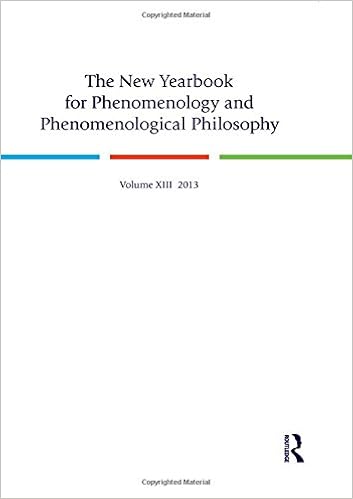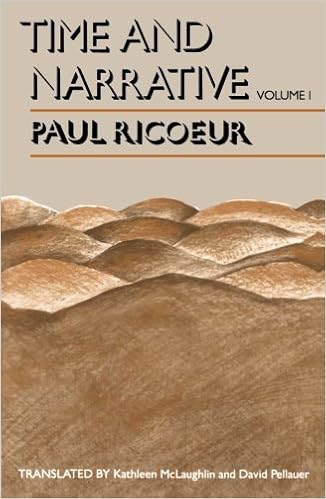
The New Yearbook for Phenomenology and Phenomenological Philosophy presents an annual foreign discussion board for phenomenological examine within the spirit of Husserl's groundbreaking paintings and the extension of this paintings by means of such figures as Scheler, Heidegger, Sartre, Levinas, Merleau-Ponty and Gadamer.
Read Online or Download The New Yearbook for Phenomenology and Phenomenological Philosophy: Volume 13 PDF
Similar Phenomenology books
Time and Narrative, Volume 1 (Time & Narrative)
Time and Narrative builds on Paul Ricoeur's previous research, within the Rule of Metaphor, of semantic innovation on the point of the sentence. Ricoeur right here examines the construction of which means on the textual point, with narrative instead of metaphor because the ruling main issue. Ricoeur reveals a "healthy circle" among time and narrative: time is humanized to the level that it portrays temporal adventure.
Phenomenology, including Marxism, pragmatism, and analytic philosophy, ruled philosophy within the 20th century—and Edmund Husserl is generally inspiration to were the 1st to enhance the idea that. His perspectives prompted a number of very important later thinkers, equivalent to Heidegger and Merleau-Ponty, who finally became phenomenology clear of questions of data.
The philosophical paintings of Jean-Luc Marion has opened new methods of conversing approximately spiritual convictions and studies. during this exploration of Marion’s philosophy and theology, Christina M. Gschwandtner offers a accomplished and demanding research of the guidelines of saturated phenomena and the phenomenology of givenness.
Extra info for The New Yearbook for Phenomenology and Phenomenological Philosophy: Volume 13
This abstraction is its nonequivalence to such predicate senses. as the item isn't the related as its predicate senses, it may be wonderful from them. an analogous aspect holds while Husserl describes all the predicate senses as an X. For Husserl “distinct senses are relating to an analogous item in simple terms insofar as they're able to being ordered into unities of feel, unities within which the determinable Xs of the unified [lower point] senses in attaining a accident with one another and with the X of the full feel of the continuing solidarity of experience” (272–73). Such twist of fate isn't really an identity. it isn't a cave in of a development and its element of unification. after we establish a development, we will be stated to understand the foundation for a predicable experience. The feel itself is a one-in-many. As such, it contains the concept of a typical referent for the sequenced multiplicity, therefore the trend, that kinds its foundation. The referent is the pattern’s “point of unification. ” hence the reduce point senses, that are in response to specific styles, discuss with the object’s positive factors via their specific issues of unification, their “determinable Xs. ” The latter confer with the thing itself whilst those determinable Xs are themselves taken as having a unmarried referent, this being “the X of the entire experience. ” this kind of overall feel contains the full trend, simply because the person senses comprise the person styles such as the good points. The circulate from the 1st set of styles to the whole development is right here mediated by means of the “determinable Xs” of the predicate senses. greedy them, we grab the gains. The non-identity of the beneficial properties with the article is a functionality of the X of the item, taken as “pure X in abstraction from its attainable predicates. ” What drives Husserl to this speak of the “X” is the nonequivalency inherent within the perceptual method. within the perceptual stream, as he writes, the article “is constantly apprehended, yet regularly provides itself in a different way; it truly is ‘the related’ yet is given with different predicates, with one other choosing content material” (271). the thing is equal to a one-in-many. As such, in spite of the fact that, it isn't akin to the multitude it unifies. A unmarried perceptually dependent predicate 54 JAMES MENSCH feel can't on its own posit the X—say, the field. To opposite this, the X can't reveal its “total feel” (Gesamtsinn) in one predicate experience. A fortiori an analogous element holds with admire to the relation among a person belief and the article. Strictly conversing, we don't “see” the field. As a complete harmony of senses, the field is absent at the perceptual point. To posit it as whatever there, affording us perceptions, we need to take it as a correlate of an indefinitely extendible diversity of perceptions. Its nonequivalence to our retained perceptions, which shape a finite assortment, underlies the idea of its transcendence. To take it as transcendent, we even have to imagine that we will be able to go back to it time and again because the comparable item. We think that it really is there even if we elect to not regard it.



